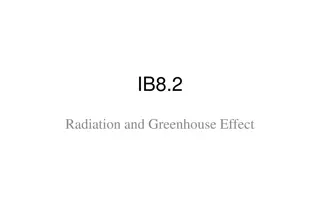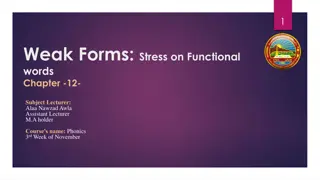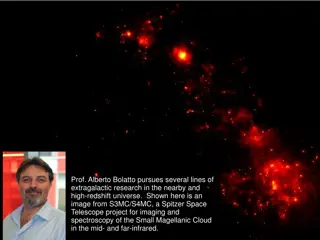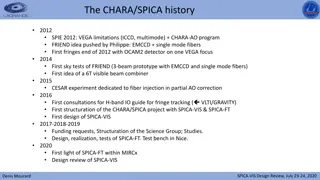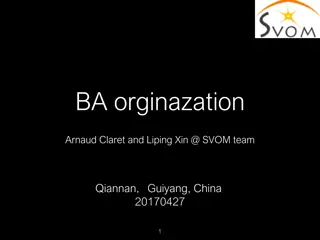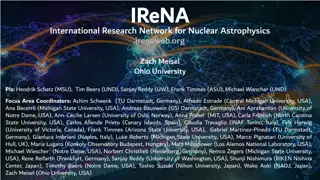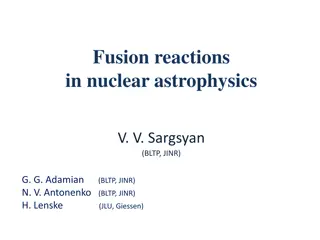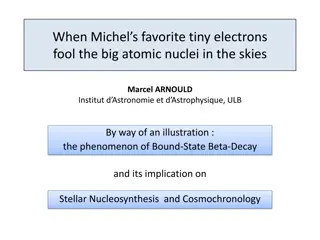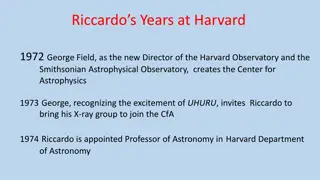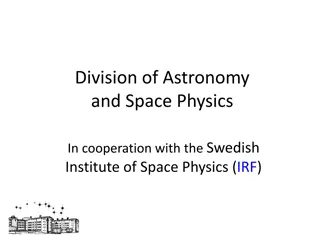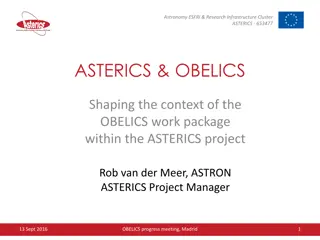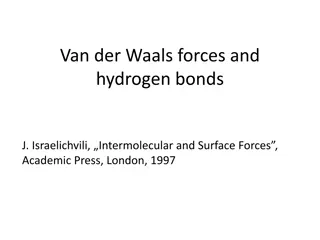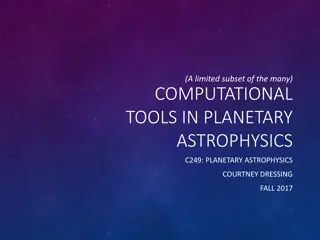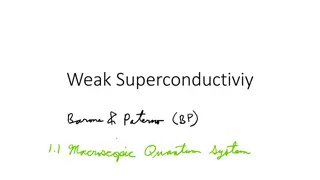Probing Weak Interactions in Astrophysics
Despite progress, lack of accurate weak interaction data remains a challenge in simulating astrophysical phenomena. Explore how charge-exchange reactions and double beta decay play crucial roles in understanding galactic evolution and nucleosynthesis.
Download Presentation

Please find below an Image/Link to download the presentation.
The content on the website is provided AS IS for your information and personal use only. It may not be sold, licensed, or shared on other websites without obtaining consent from the author.If you encounter any issues during the download, it is possible that the publisher has removed the file from their server.
You are allowed to download the files provided on this website for personal or commercial use, subject to the condition that they are used lawfully. All files are the property of their respective owners.
The content on the website is provided AS IS for your information and personal use only. It may not be sold, licensed, or shared on other websites without obtaining consent from the author.
E N D
Presentation Transcript
Charge-exchange reactions as a tool for probing weak interactions of relevance for astrophysics and double beta decay Remco G.T. Zegers For the NSCL Charge-Exchange group and Collaborators INTERNATIONAL SCHOOL OF NUCLEAR PHYSICS 39th Course Neutrinos in Cosmology, in Astro-, Particle- and Nuclear Physics Erice-Sicily: September 16-24, 2017
2 basic questions I. How can one test and improve weak reaction rates that are used in simulations of explosive astrophysical phenomena and help us understand their evolution and contribution to galactic chemical evolution and nucleosynthesis? II. How can we constrain and improve the matrix elements that enter calculations for (neutrinoless) double beta decay?
Question I weak rates in astrophysics Despite experimental and theoretical progress, lack of knowledge of relevant or accurate weak-interaction data still constitutes a major obstacle in the simulation of some astrophysical scenarios today (2003). K. Langanke and G. Martinez-Pinedo, RMP 75, 819 (2003). Cooling & heating in accreting neutron star crusts Core-collapse supernovae Thermonuclear supernovae Z. Meisel et al. Sean M. Couch Electron capture, -decay, and neutrino interactions play important role in many astrophysical phenomena and processes, yet the relevant rates are poorly constrained
electron capture rates on nuclei Dominated by allowed (Gamow-Teller L=0, S=1, T=1) weak transitions between states in the initial and final nucleus. Each transitions is characterized by a Q-value and a strength, B(GT). on groundstate EC on exited state from groundstate Due to finite temperature in stars, Gamow-Teller transitions from excited states in the mother nucleus can occur j= Direct empirical information on strength of transitions [B(GT)] is limited to low-lying excited states e.g. from the inverse ( -decay) transitions, if at all EC rates on many (unstable) nuclei are important. Only fraction of transitions can be measured. Must rely on theoretical models benchmarked by experiments. Ex j=3 j=2 Qg.s. g.s. j=1 groundstate i=2 i=1 groundstate Daughter (Z,A) Mother (Z+1,A)
Question II - Double beta decay Can one derive 2 half-lives from GT Matrix elements? Phases? Can we constrain the theoretical models used for estimating matrix elements for and half-lives for 0 ? If 0 were to be discovered, can we have calculate matrix elements that are sufficiently accurate to learn something about the neutrino masses?
Charge-exchange reactions & /EC-decay ?? ? ?=0 Perform experiments ~ 100 AMeV or above = ??(??) 2 The unit cross section is calibrated against transitions for which - decay data are available ? ??= ?? ?? ?(??)
Producing a triton beam for (t,3He) experiments Primary 16O beam 150 MeV/n rate @ A1900 FP 1.2x107pps @ 130 pnA 16O transmission to S800 spectrometer ~70% 3H rate at S800: up to 2x107 pps S800 spectrometer Reconstruct momentum and angle of 3He particle Extract excitation- energy and center-of- mass scattering angle from two-body kinematics Without wedge Thin wedge is needed to remove 6He (9Li) Background channel 6He->3He + 3n 7 G.W. Hitt Nucl. Instr. and Meth. A 566 (2006), 264.
Multipole decomposition 1 Multipole Decomposition Analysis 3 2 0 1 2 3 4 5 C. Guess et al., Phys. Rev. C 80, 024305 (2009)
56Fe(t,3He) Result from multipole decompositions analysis Experiment 56Fe(t,3He) - M. Scott et al., PRC 90, 025801 (2014) 56Fe(n,p) - S. El-Kateb et al., PRC 49, 3128 (1994) 56Fe(d,2He) D. Frekers et al. in analysis Theory Shell model KB3G - A. Poves et al., NPA694, 157 (2001) GXPF1a - M. Honma et al. PRC 65, 061301(R) (2002) Used in astrophysical modelling Theory QRPA P. Moller and J. Randrup, NPA514, 1 (1990); S. Gupta
46Ti(t,3He) Contribution of excited states (at Q>0) to electron-capture rate Large differences between theory and data are observed for 46Ti How to identify important, but weak low-lying states? S. Noji et al., Phys. Rev. C 92, 024312 (2015), Phys. Rev. Lett. 112, 252501 (2014)
(t,3He) & (t,3He+) S800 Spectrograph (+Gretina) Gretina -detection Gamma-Ray Energy Tracking In-beam Nuclear Array 3He ejectiles S800 3H (100 MeV/u) ~10M pps target (~10 mg/cm2)
Low-lying GT strength: 46Ti(t,3He+) For 46Ti: weak low-lying GT transition is observed in -coincident data: B(GT)0.991=0.009 0.005(exp) 0.003 (sys) Not Separable in singles data.
Electron-capture rates in pre-supernovae star This low-lying transition is important for estimating an accurate electron-capture rate in pre-supernovae stars.
(p,n) in inverse kinematics S800 spectrometer Heavy residue collection B < 4 Tm /130o bend Particle identification Diamond detector Beam particle timing 30 cm Low Energy Neutron Detector Array (LENDA) neutron detection Plastic scintillator 24 bars 2.5x4.5x30cm 150 keV < En < 10 MeV En ~ 5% n < 2o efficiency 15-40% n RI beam Liquid Hydrogen target proton target 65 mg/cm2 (~7 mm) ~3.5 cm diameter T=20 K ~1 atm 14
Experiment on key nuclei can reveal and clarify specific differences between theoretical models 56Ni(p,n) in inverse kinematics provided key input for understanding the difference between leading shell- model calculations Experiment provided information on important nucleus for astrophysics M. Sasano et al., Phys. Rev. C 86, 034324 (2012), Phys. Rev. Lett. 107, 202501 (2011)
Systematic EC rate comparisons Systemic comparison of EC rates calculated from theory and derived from data provide framework for error estimation of theoretical rates Systematic studies provide a way to benchmark and improve theoretical calculations Experimental results from different facilities and probes are combined to perform comprehensive comparisons A.L. Cole et al., PRC 86, 015809 (2012)
New weak rate library C. Sullivan et al., Ap. J., 816, 44 (2015) https://github.com/csullivan/weakrates Open source library aims to standardize the incorporation of weak rates in astrophysical simulations Library is implemented into neutrino-interaction library NuLib (http://www.nulib.org/; E. O Connor); plain rate table with recommended rates will soon be available as well.
Sensitivity Study of Core Collapse Supernovae C. Sullivan et al., Ap. J., 816, 44 (2015) GR1D simulation with modern weak rate estimates up to 100 ms after bounce Calculations guide experimental and theoretical efforts, building on previous work focused on EC rates by e.g. Mart nez-Pinedo, Langanke, Hix, Heger Which nuclei contribute most to deleptonization of central zone? R. Titus et al., to be published
Sensitivity study of key parameters of CCSN By varying the EC rate within uncertainties of theoretical rates models determined by benchmarking against experiments, the sensitivity of the core-collapse simulations to input weak rates can be compared with other uncertainties, such as in progenitor and equation-of-state models Strong impact on spectra: EC Variation: Time (ms) 19
Library is already used in GR1D (1D), CoCoNuT (2D), FLASH (3D) core-collapse simulation codes S. Richters et al., Phys. Rev. D 95, 063019 (2017) Uncertainties in frequency of gravitational waves from CCSNe due to uncertainties in EC rates is comparable to the uncertainties in EoS 20
GT+ strengths along N=50 10p R. Titus et al., to be published
88Sr(t,3He+) very preliminary There appears to be very little GT+ strength at low excitation energy coincidence data is being analyzed online analysis also indicated that known 1+ states were not (or very weakly) populated Also investigating 86Kr and 93Nb data (88Rb) J. Zamora, B. Gao, R. Titus et al. Pauli-blocking along N=50 appears stronger than expected from theoretical estimates In high-temperature stellar environments, thermal Pauli unblocking can be strong. To accurately describe this temperature-dependent Pauli unblocking, the T=0 system must be well described and tested by experiment.
100Mo(3He,t) RCNP Osaka J. Thies et al., Phys. Rev. C 86, 044309 (2012)
Gamow-Teller strengths near N=50 Gamow-Teller strengths for medium-heavy nuclei are poorly constrained Pauli-blocking effects lead to strong reduction in transition strength K. Miki et al., PLB 769, 339, (2017) Gamow-Teller strengths extracted from 100Mo(t,3He) experiment at NSCL indicate that the inclusion of deformation is necessary, but not sufficient, for making accurate predictions and thus calculate reliable EC rates. 24
Question II - Double beta decay Can one derive 2 half-lives from GT Matrix elements? Phases? Can we constrain the theoretical models used for estimating matrix elements for and half-lives for 0 ? If 0 were to be discovered, can we have calculate matrix elements that are sufficiently accurate to learn something about the neutrino masses?
Double beta decay: the case of 150Nd Most 0/2 partners have over the past decade been investigated through charge- exchange reactions: (3He,t) RCNP (d,2He) KVI (p,n)/(n,p) RCNP (t,3He) NSCL RCNP Osaka U. NSCL MSU Goal: test the theoretical models used to estimate double beta decay half lives under the premises that models that aim to accurately estimate matrix elements for double beta decay must be able to accurately estimate matrix elements for single beta decay
150Nd(3He,t) and 150Sm(t,3He) data C. Guess et al., Phys. Rev. C 83, 064318 (2011) 150Sm(t,3He) at 115 AMeV 150Nd(3He,t) at 140 AMeV
Multipole Decomposition Analysis Gamow-Teller Resonance (3He,t) (t,3He) Spin-dipole resonance
Comparison with QRPA calculations Isovector Spin Giant Monopole Resonance Calculations by Fang, Rodin et al.
Conclusions & Outlook Charge-exchange experiments are useful tools for studying Gamow-Teller strength distributions in nuclei and are key to the development of accurate theoretical models with applications in astrophysics and neutrino physics Extension to forbidden transitions? Applicability of proportional relationship between CE cross section and strength less clear and extraction becomes less model independent First CE experiments in inverse kinematics with rare isotopes have been successfully performed probes used are (p,n) and (7Li,7Be) in inverse kinematics. (d,2He) in inverse kinematics is in development Ability to study CE reaction far from stability at next generation rare-isotope beam facilities RIBF, FAIR, FRIB
High-Rigidity Spectrometer at FRIB (Status of FRIB: See talk by Alexandra Gade)
EC rates in nuclear astrophysics Graduate students Sam Lipschutz Chris Sullivan (CCSN calculations) Rachel Titus (86Kr) Jaclyn Schmitt Previous members who analyzed data shown in this presentation: Carol Guess (A=150) Masaki Sasano (56Ni) Kenjiro Miki (100Mo) Postdocs Juan Zamora (88Sr) Bingshui Gao (93Nb) And Sam Austin Daniel Bazin Jorge Pereira Shumpei Noji (45Sc,46Ti) M. Scott, Y. Shimbara (56Fe) A.L. Cole and our local and outside collaborators, in particular Alex Brown, the NSCL gamma group (Alexandra Gade, Dirk Weisshaar), H. Schatz, Ed Brown, Sean Couch, Sean Liddick, Artemis Spyrou, Andreas Stolz, Evan O Connor (NCSU), Yoshi Fujita (Osaka U.), Muhsin Harakeh (KVI), Dieter Frekers (U. Muenster), Sanjib Gupta (IITR), Hide Sakai (RIKEN), Tomohiro Uesaka (RIBF), Elena Litvinova, Caroline Robin (WMU), Karlheinz Langanke (GSI), Gabriel Mart nez-Pinedo (TU Darmstadt), Lew Riley (Ursinus), B. Rubio (IFIC,Valencia)Gianluca Col (Milano), Gretina collaboration, A1900 and CCF staff, and many others! This work was supported by the US NSF grant PHY-1430152 (Joint Institute for Nuclear Astrophysics Center for the Evolution of Elements). GRETINA was funded by the US DOE Office of Science. Operation of the array at NSCL is supported by NSF under Cooperative Agreement PHY-1565546 (NSCL) and DOE under grant DE-AC02-05CH11231 (LBNL)
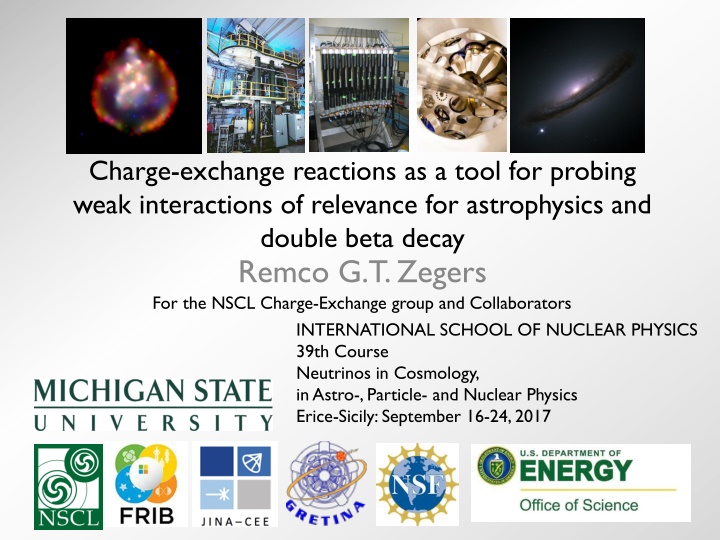

![[PDF⚡READ❤ONLINE] Black Hole Astrophysics: The Engine Paradigm (Springer Praxis](/thumb/21503/pdf-read-online-black-hole-astrophysics-the-engine-paradigm-springer-praxis.jpg)
![[PDF⚡READ❤ONLINE] Cosmology and Particle Astrophysics (Wiley-Praxis Series in As](/thumb/21627/pdf-read-online-cosmology-and-particle-astrophysics-wiley-praxis-series-in-as.jpg)
